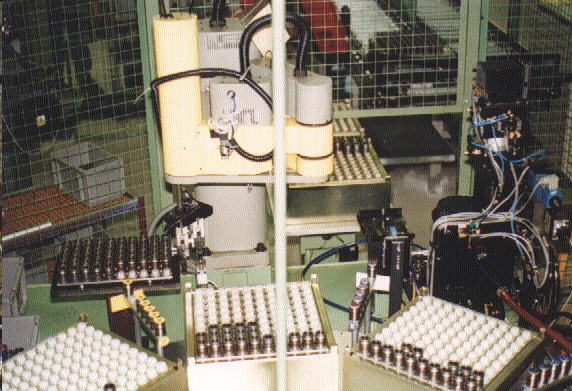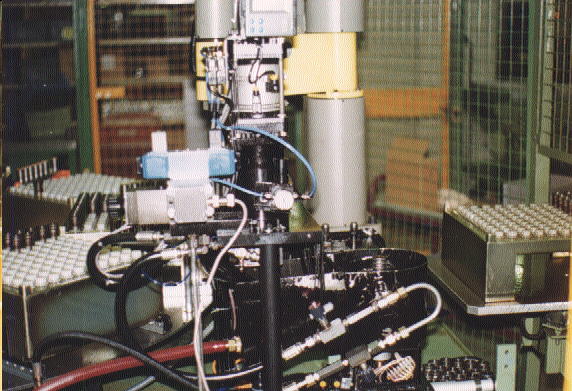
| Introduction : |
Today, the vast majoriy of motor vehicles are fitted with every kind of assistance for the driver. The most common - power assisted steering - is now fitted as standard to all but the smallest and cheapest cars. Such a huge increase in the fitting of power steering has resulted in one major manufacturer building new factories in several european countries, together with launching impressive expansion plans in its existing plants. Quality is paramount, and the response of power steering systems is balanced within 18 seconds of arc from lock to lock. Robotix worked together with TRW Steering Systems ( Dijon - France ) to design, build and install two hydraulic valve sleeve grading systems to inspect the sleeves under real life conditions. |
| Sankyo robot picks valve sleeves from infeed pallet : |
 |
| Solution : |
In the photograph above, the Sankyo robot picks the next sleeve from a pallet of 100 sleeves and loads it to an orientation station. The sleeve rotates, and the robot looks for a small dowel pin hole in the sleeve's skirt. The angular location of the dowel pin hole indicates the starting position for the test process. The robot loads the sleeve into the master shaft in the centre of the test station, and initiates the test. |
| Test and orientation stations : |
 |
| Test Procedure : | |
The test station closes over the sleeve, clamping the sleeve to prevent it rotating and sealing in the hydraulic fluid. The hydraulic fluid begins to flow, flooding the sleeves galleries and purging air from the system. The master shaft rotates a few degrees forward and backward, whilst the test computer logs the flow rate of hydraulic fluid and the pressure across the output ports of the valve. Approximately 2000 sets of readings are taken, one set every 0.005 degree of master shaft rotation - each reading is plotted on the computer screen ( below left ). |
|
|
|
|
Having gathered the pressure and flow rate data relative to shaft rotation angle ( 6000 readings ), the computer software smooths out the data, discarding any erroneous values, before calculating the differential pressure drop across the valve. This data is also presented on the computer screen. The software analyses the differential pressure curve, looking for two points where the value exceeds 5 bar. The hysteresis of the points are checked and triangulated values calculated to give the precise angle through which the shaft must be rotated to create +/- 5 bar differential pressure drop. This part calculated, part measured angle identifies which one of 16 grades the sleeve belongs to. The robot unloads the sleeve, and palletises it with like graded sleeves - ready for the selective assembly process to begin. Statistical data ( shown in the photograph above right ) gives quality details to the engineers, proving that the system performs within 6 Sigma. |
|